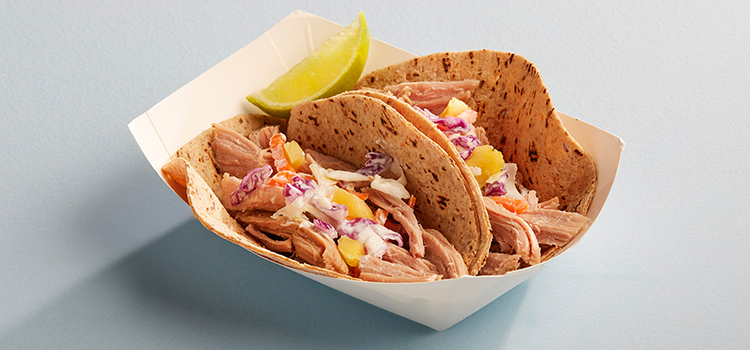This post is sponsored by Butterball Foodservice.
The ability to create many different meals from just a few staple ingredients has long been a goal in school foodservice, and that versatility is especially important for the 2020-21 school year. In this interview, Butterball Foodservice’s Frank Samuelson discusses the advantages of fully cooked turkey products for creating a wide variety of meals that work in the cafeteria, the classroom or for grab-and-go.
Why is versatility and the ability to use one product to create many different meals increasingly important in school foodservice?
With any foodservice operation, especially the K-12 segment, any time an operator can take one item, such as turkey, and use it over multiple menu spaces, it’s ideal for several reasons. First, it allows the operator to decrease the number of inventory items. Next, it’s easier to train staff on how to prepare one main item several different ways versus having to train employees on multiple items. Last, distributor partners can offer better service levels to the operator if the number of items required to produce a daily, weekly, or monthly menu are held to a minimum. In other words, the fewer items on the order guide, the less chance there is of shorts and substitutions.
What makes turkey an especially versatile protein for school meals?
Turkey is ideal for K-12 menus for a variety reasons. It’s lean, high in protein and contains all the B vitamins. It’s particularly high in B3, B6 and B13, which are essential in turning food into energy. Additionally, with the ever-increasing diverse cultures and special dietary needs in schools today, turkey helps operators offer healthy alternatives to pork or beef at breakfast and lunch.
The wide variety of dayparts and menuparts that turkey can be used for makes it an ideal option for operators at a very affordable price point compared to other proteins, too. Turkey is truly versatile, available in a variety of product types that can be served at breakfast, lunch, for after school snacks or take-home dinners.
What Butterball products do you feel offer the most versatility to K-12 operators?
All of our Butterball K-12 products offer endless flexibility, but my two favorites are the Turkey Thigh Roast and the Turkey Tenderloin Medallions. The Turkey Thigh Roast can be used as a stand-alone pot roast style entrée just as easily as it can be used in Mexican, Asian and Southern BBQ dishes, like Jerk Turkey Street Tacos or Sticky Orange Turkey. The Turkey Tenderloin Medallions can be served hot or in cold dishes like our Asian Turkey Salad. As the holidays approach, they’re also a perfect fit for a school’s Thanksgiving dinner celebration.
How do fully-cooked proteins help reduce labor for school foodservice operators?
Over the last few decades, K-12 foodservice operators have increasingly migrated from scratch cooking to fully cooked products for many reasons. First and foremost, food safety and the desire to protect students drove demand as fully cooked products cut down on the chances of over/under cooking and contamination. K-12 directors have also been tasked to deliver more meals with the same or fewer number of personnel, resulting in an increased need for products that can be easily prepared. Butterball is unique in that we’ve brought to market fully cooked items that look like “scratch cooking,” giving operators peace of mind when it comes to food safety and reducing labor while serving nutritious, delicious meals.
What are some meal formats made with turkey that can easily be adapted for grab-and-go?
Well even before the COVID-19 health crisis, K-12 operators had a need for meals that could be used in grab-and-go or self-serve scenarios. In 2020 though, we have seen this need expand and evolve to accommodate the Summer Food Service Program and Seamless Summer Option, which the USDA has extended through the end of the 2020 calendar year. The initial request from K-12 operators when schools closed was for thaw-and-serve or individually wrapped items. The variety of sliced turkey available (ham, bologna, salami, breast etc.) works well in this scenario, but as the weeks became months, we witnessed schools going beyond thaw-and-serve meals to include hot entrées as well. Once again demonstrating turkey’s flexibility, our Ready To Cook Breast and Turkey Thigh Roast are two examples of how turkey can be used in hot applications.
With the variety of current learning platforms — including on-campus learning, completely virtual learning and a hybrid model that employs both in-person and virtual classrooms — the need to feed children is even more important than it was before. However, it’s now significantly more challenging for K-12 directors and their staff. Thankfully, K-12 suppliers have adapted very quickly and extremely well to the needs of customers. At Butterball, we are proud to say that we have stepped up with a K-12 line of products that can accommodate any and all needs. We are committed to being the go-to partner for our school foodservice customers and helping them to ensure that the children get their much-needed daily nutrition with flavorful products that children will love and parents will feel good about.
For more information and recipe inspiration, download this infographic on creating flexible menus with turkey.
Frank Samuelson is Butterball Foodservice’s national business development manager for K-12 schools. He is responsible for leading commercial bid and commodity processing efforts, maintaining relationships with key stakeholders and driving sales volume. Samuelson has over 25 years of experience in the foodservice industry, with 18 of those spent in the poultry segment.
